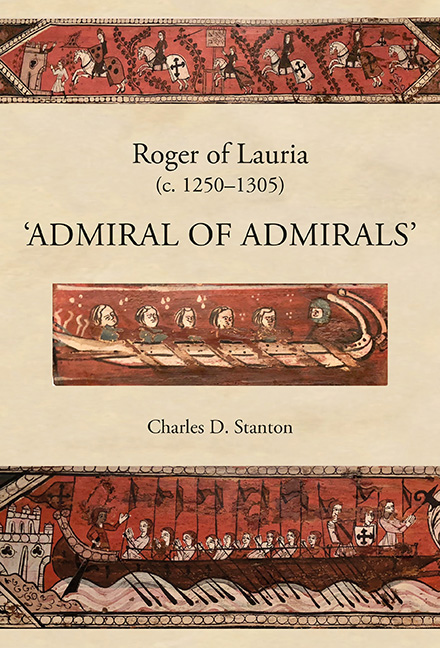Book contents
- Frontmatter
- Dedication
- Contents
- List of Illustrations
- Prologue
- 1 Battle of Benevento (26 February 1266)
- 2 A Calabrian Exile in the Court of Aragon (1262–1282)
- 3 Battle of Tagliacozzo (23 August 1268)
- 4 Aragonese Expansion (1229–1282)
- 5 Angevin Consolidation and Aggrandizement (1268–1282)
- 6 Revolt of the Vespers (30 March 1282)
- 7 Aragonese Intervention (August–October 1282)
- 8 Stalemate (November 1282–March 1283)
- 9 Admiral of Aragon (20 April 1283)
- 10 The Opposing Fleets (1282–1302)
- 11 Battle of Malta (8 June 1283)
- 12 Anjou's Dreams of Empire Dashed (June–November 1284)
- 13 France's Crusade Against Aragon (May–November 1285)
- 14 Battle of the Counts (23 June 1287)
- 15 Truces and Treaties (June 1287–November 1291)
- 16 Raid on Romania (Summer 1292)
- 17 Switching Sides (December 1293–April 1297)
- 18 Aragon's Invasion of Sicily at Anjou's Bidding (1298/1299)
- 19 Lauria's Last Great Campaign (Summer 1299–Spring 1300)
- 20 Endgame (Spring 1301–Summer 1302)
- Epilogue
- Bibliography
- Index
18 - Aragon's Invasion of Sicily at Anjou's Bidding (1298/1299)
Published online by Cambridge University Press: 24 October 2019
- Frontmatter
- Dedication
- Contents
- List of Illustrations
- Prologue
- 1 Battle of Benevento (26 February 1266)
- 2 A Calabrian Exile in the Court of Aragon (1262–1282)
- 3 Battle of Tagliacozzo (23 August 1268)
- 4 Aragonese Expansion (1229–1282)
- 5 Angevin Consolidation and Aggrandizement (1268–1282)
- 6 Revolt of the Vespers (30 March 1282)
- 7 Aragonese Intervention (August–October 1282)
- 8 Stalemate (November 1282–March 1283)
- 9 Admiral of Aragon (20 April 1283)
- 10 The Opposing Fleets (1282–1302)
- 11 Battle of Malta (8 June 1283)
- 12 Anjou's Dreams of Empire Dashed (June–November 1284)
- 13 France's Crusade Against Aragon (May–November 1285)
- 14 Battle of the Counts (23 June 1287)
- 15 Truces and Treaties (June 1287–November 1291)
- 16 Raid on Romania (Summer 1292)
- 17 Switching Sides (December 1293–April 1297)
- 18 Aragon's Invasion of Sicily at Anjou's Bidding (1298/1299)
- 19 Lauria's Last Great Campaign (Summer 1299–Spring 1300)
- 20 Endgame (Spring 1301–Summer 1302)
- Epilogue
- Bibliography
- Index
Summary
IN THE AFTERMATH OF CATANZARO, the lack of an effective naval force initially prevented the Angevin–papal coalition from making much progress in its quest to wrest Sicily from Frederick. The only favourable development was the defection to the Angevin cause of Catalan captain Berenguer de Sarria (a colleague of Lauria), who cobbled together a flotilla of twenty galleys to raid Marsala, Malta and Pantelleria in February 1298. When Frederick quickly equipped around thirty galleys at Palermo to hunt him down, Sarria set course back to Naples, however, leaving little lasting damage in his wake. Thus, it became painfully apparent that there was no real hope of returning Sicily to Angevin control unless James of Aragon was convinced to assume a more active role in the endeavour. Accordingly, Pope Boniface ardently renewed his entreaties to King James, promising to finance his participation with papal tithes. He also persuaded the king's uncle, James II of Majorca, to pledge his allegiance to the Crown of Aragon as a condition for the return of the Balearics to his suzerainty. This arrangement also satisfied the latter's ally, Philip IV of France, engendering a general peace between the two kingdoms. Furthermore, a truce with Ferdinand IV of Castile temporarily freed Aragon from peninsular entanglements. In sum, the timing was finally right for James to help resolve the Sicilian issue once and for all.
SIEGE OF SYRACUSE (AUTUMN 1298/WINTER 1299)
That spring, James applied his papal bounty to the assembly of an 80-ship fleet (30 Provençal galleys and 50 Catalan). Marino Sanudo Torsello claimed that it carried 1,200 cavalry and 20,000 almugavars, but Giovanni Amatuccio relied on Angevin records to reach a more reasonable estimate of 500 knights and 3,000 infantry of mixed ethnic origins. No matter the exact numbers, it was a formidable force that represented a clear and present danger to Frederick and his Sicilian subjects. The arming of such an armada and its purpose could not have been kept secret from the young sovereign. After all, its mariners and military personnel had been recruited from Aragon, Catalonia, France, Provence and the Regno. Consequently, on 15 April Frederick hired Corrado Doria, a former Genoese fleet commander and Capitano del Popolo (‘Captain of the People’), to hurriedly equip a fleet of 64 ships, upon which some 700 horsemen were embarked.
- Type
- Chapter
- Information
- Roger of Lauria (c.1250–1305)‘Admiral of Admirals’, pp. 256 - 270Publisher: Boydell & BrewerPrint publication year: 2019

